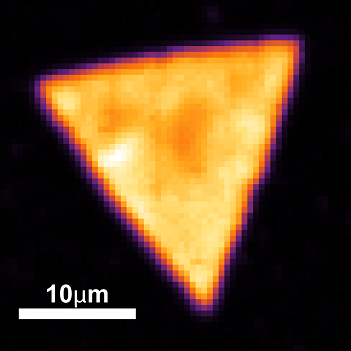Exciton polaritons in two-dimensional semiconductors
 Atomically thin crystals of transition metal dichalcogenides (TMDs) host excitons with strong binding energies and sizable light-matter interactions. Coupled to optical cavities, monolayer TMDs routinely reach the regime of strong light-matter coupling, where excitons and photons admix coherently to form quasiparticles known as polaritons up to room temperature. We explore the two-dimensional nature of TMD polaritons with cavity-assisted hyperspectral imaging. We record a spatial map of polariton properties of extended WS2 monolayers coupled to a tunable micro cavity in the strong coupling regime, and correlate it with maps of exciton extinction and fluorescence taken from the same flake with the cavity. We find a high level of homogeneity, and show that polariton splitting variations are correlated with intrinsic exciton properties such as oscillator strength and linewidth. Moreover, we observe a deviation from thermal equilibrium in the resonant polariton population, which we ascribe to non-Markovian polariton-phonon coupling. Our measurements reveal a promisingly consistent polariton landscape, and highlight the importance of phonons for future polaritonic devices. [Gebhardt et al., Sci. Rep. (2019)]
Atomically thin crystals of transition metal dichalcogenides (TMDs) host excitons with strong binding energies and sizable light-matter interactions. Coupled to optical cavities, monolayer TMDs routinely reach the regime of strong light-matter coupling, where excitons and photons admix coherently to form quasiparticles known as polaritons up to room temperature. We explore the two-dimensional nature of TMD polaritons with cavity-assisted hyperspectral imaging. We record a spatial map of polariton properties of extended WS2 monolayers coupled to a tunable micro cavity in the strong coupling regime, and correlate it with maps of exciton extinction and fluorescence taken from the same flake with the cavity. We find a high level of homogeneity, and show that polariton splitting variations are correlated with intrinsic exciton properties such as oscillator strength and linewidth. Moreover, we observe a deviation from thermal equilibrium in the resonant polariton population, which we ascribe to non-Markovian polariton-phonon coupling. Our measurements reveal a promisingly consistent polariton landscape, and highlight the importance of phonons for future polaritonic devices. [Gebhardt et al., Sci. Rep. (2019)]
Analogous concepts for hybrid light-matter systems employing spatially indirect excitons with a permanent electric dipole moment in heterobilayer crystals promise realizations of exciton-polariton gases and condensates with inherent dipolar interactions. Here, we implement cavity-control of interlayer excitons in vertical MoSe2-WSe2 heterostructures. Our experiments demonstrate the Purcell effect for heterobilayer emission in cavity-modified photonic environments, and quantify the light-matter coupling strength of interlayer excitons. The results will facilitate further developments of dipolar exciton-polariton gases and condensates in hybrid cavity – van der Waals heterostructure systems. [Förg et al., Nature Commun. (2019)]

